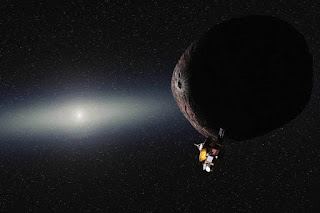 |
| Artist's illustration of the New Horizons spacecraft flying by the Kuiper Belt object 2014 MU69 on Jan. 1, 2019 Credit: NASA/JHUAPL/SwRI/Alex Parker |
To Pluto and beyond!
Nearly two years after its historic encounter with the dwarf planet Pluto, NASA's New Horizons spacecraft is getting ready for its next big adventure in the icy outskirts of the solar system.
Now, the spacecraft is on its way to a small, ancient object located about 1 billion miles (1.6 billion kilometers) beyond Pluto in the Kuiper Belt. This distant region surrounds the solar system and is filled with trillions of icy rocks that have yet to be explored. The new target was discovered by the Hubble Space Telescope in June 2014, and it was dubbed 2014 MU69.
A world of discoveries
It took the spacecraft about 16 months to beam back all of its data from the Pluto flyby, and planetary scientists have had a ball with that data.
"The New Horizons flyby of the Pluto system was completely successful, and now we've got all the data on the ground and we're putting a bow around it," Alan Stern, the New Horizons principal investigator at Southwest Research Institute, said in a Facebook Live event on Thursday (Jan. 19).
Thanks to New Horizons, scientists now have a global map of Pluto and the most detailed images yet of the dwarf planet's bizarre, mountainous landscape and icy volcanoes. Tall mountain ranges seen on Pluto also suggest recent geological activity on the dwarf planet's surface.
Space.com: Beyond Pluto: NASA's New Horizons Spacecraft Heads to Next AdventureHanneke Weitering, Staff Writer-Producer
Comments